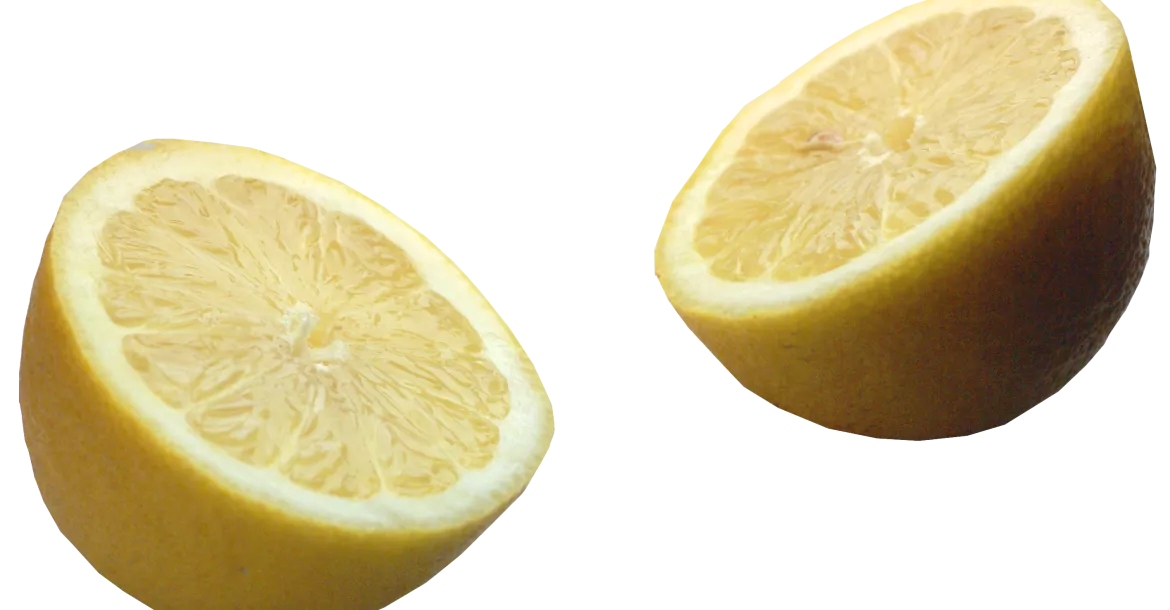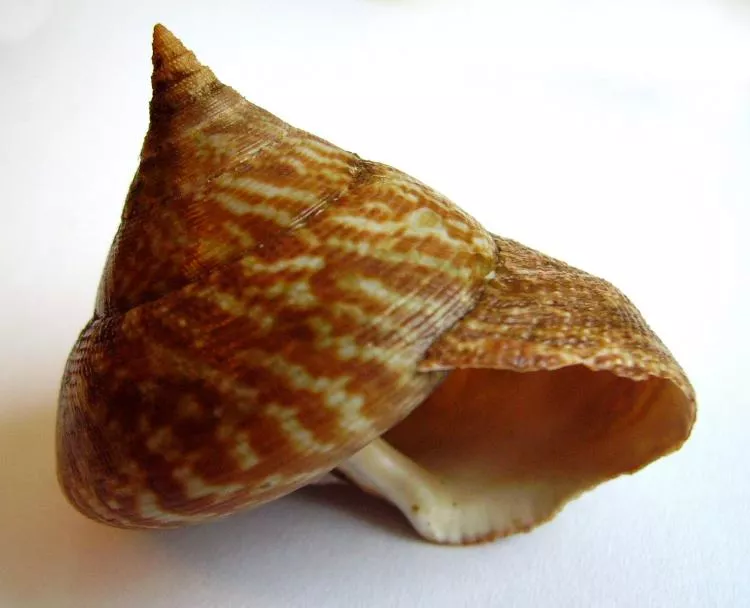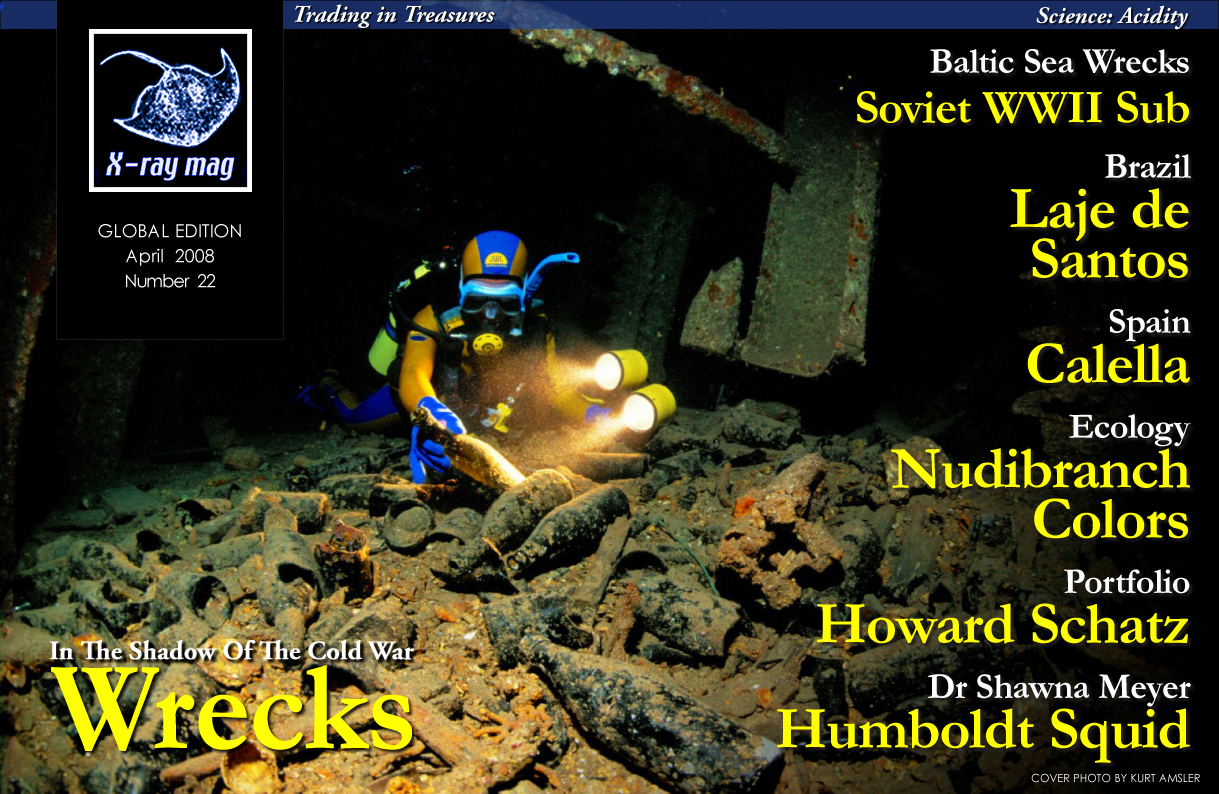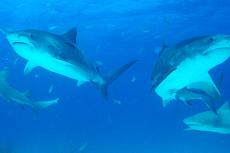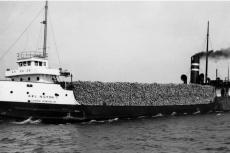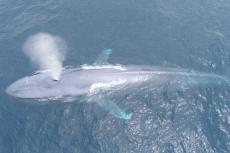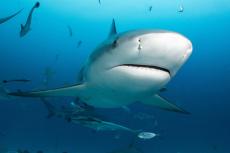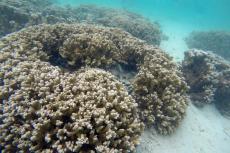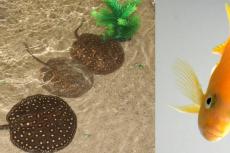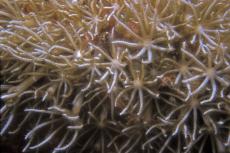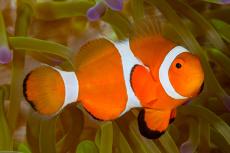There has been much discussion in recent years about the effect of increasing global temperatures on marine fauna (see also the last issue of this magazine). However, it has often been overlooked that the increasing acidity of the oceans may have an even greater, and more insidious, effect on marine life than just a simple rise in temperature.
Contributed by
The absorbtion of CO2 may have slowed global warming, but there has been a resulting change in seawater chemistry. To understand why the effect of increasing atmospheric CO2, which leads to increased absorbtion of CO2 in sea water, is important, it is necessary to understand some of the chemistry of carbonic acid and its salts.
However, before we can discuss the effect of this acidity, we must have a useful description of what we mean by acidity and acid strength. The most common and useful unit to describe the magnitude of acidity is the pH value.
Measurement of acidity using the pH scale
When compounds, be they acids, alkalies or salts of these, dissolve in water they dissociate, wholly or partly, and in some cases extremely slightly, into their component ions.
For example, the gas hydrogen chloride, HCl, dissolves in water to give the ions H+ and Cl- .
We call this solution hydrochloric acid.
Similarly, when the salt calcium sulphate, CaSO4, dissolves in water the ions Ca++ and SO4- - are formed.
Acid strength
Now, the strength of an acid such as HCl is given by number of hydrogen ions present in a given volume of acid solution. If the acid is very concentrated and therefore very strong, the concentration of hydrogen ions will be very high. The strength of the acid is therefore proportional to the concentration of hydrogen ions.
Water partially dissociates into hydrogen ions and hydroxyl ions according to the following equilibrium:
H2O <=> H+ + OH-
So water, like many other substances, can act both as an acid (having H+ ions) and as a base (having OH- ions).
The concentration of hydrogen ions, given in moles, is generally of the order of between 10-1 and 10-14 moles per litre, with water having a hydrogen ion concentration of 10-7 moles per litre. This means that water dissociates to only a very small degree.
However, these are cumbersome values to use, so the hydrogen ion concentrations are converted to the much more convenient pH values.
This is done by taking the negative of the log10 of the hydrogen ion concentration. To give an example—If the hydrogen ion concentration is 3x10-6 moles per litre then the pH value is given by:
pH = – log10(3 x 10-6)
= – (log103 - 6)
= – (0.48 - 6)
= 5.52.
It will be seen, then, that a decrease of one unit in the potential of the hydrogen ion concentration, say from 10-4 to 10-3, means a decrease of one pH unit. Accordingly, a unit decrease in pH value means a ten times increase in the hydrogen ion concentration i.e. a ten times increase in acidic strength.
The molality of hydrogen ions in pure water is actually 1.004x10-7 mol kg-1. The pH value of pure water is therefore -0.0017 + 7 i.e. 6.998 or to 2 decimal places 7.00.
As water is a neutral substance from the acid/base point of view, a pH value of 7 is considered as being midway between acid and alkali.
An aqueous solution of HCl of unit molarity, i.e. 1 mole per kg, with virtually complete dissociation, will have a pH of 0.09.
Some typical pH values
- Battery acid: ca 1
- Gastric juices: 1 – 3
- Lemon juice: ca 2.2
- Household vinegar: 2.5 to 3
- Tomato: 4.0
- Cheddar cheese: ca 5.90
- Camembert cheese: ca 7.44
- Concentrated solution of baking soda: 8.2
- Household cleaning fluids: 10 to 11
Carbonic acid
As stated above, the acidity of seawater mainly arises from the amount of CO2 in it and the acids it forms. Carbon dioxide is highly soluble in water in which it forms an equilibrium with carbonic acid,
CO2 + H2O <=> H2CO3
About 0.5% of the dissolved CO2 remains as H2CO3 with the rest immediately dissociating in the two steps given by the following equilibria:
Firstly,
H2CO3 <=> H+ + HCO3- , forming the bicarbonate ion.
Then,
HCO3- <=> H+ + CO3- - , forming the carbonate ion.
In absolute terms there are, on average, about 45ml total CO2 per litre of sea water, but because of these two equilibrium reactions, nearly all of this is found in the carbonate and bicarbonate ions. Only about 0.23ml CO2 per litre occurs as dissolved gas in the water i.e. 0.51%.
Hydrogen ions are liberated in these equilibrium reactions, which means that the pH of seawater is largely determined by the concentration of bicarbonate and carbonate ions. The pH is usually 8 ± 0.5. However, when CO2 is added to seawater, more H2CO3 is formed and the number of hydrogen ions increases. The pH thereby decreases, with the seawater thus becoming more acidic—though it might be more descriptive to say less alkaline.
The carbonate ion can interact with cations such as Ca++ and Mg++ in the seawater causing them to precipitate as insoluble carbonates. Calcium carbonate is the main constituent of chalk, limestone and marble. It has a solubility of only about 20mg per litre of cold water, and because it is so insoluble, it is an important constituent of coral reefs and mollusc shells.
However, and this is important for understanding the effect of increasing CO2 in sea water, this calcium carbonate, although it is insoluble in water, dissolves in acidic solutions.
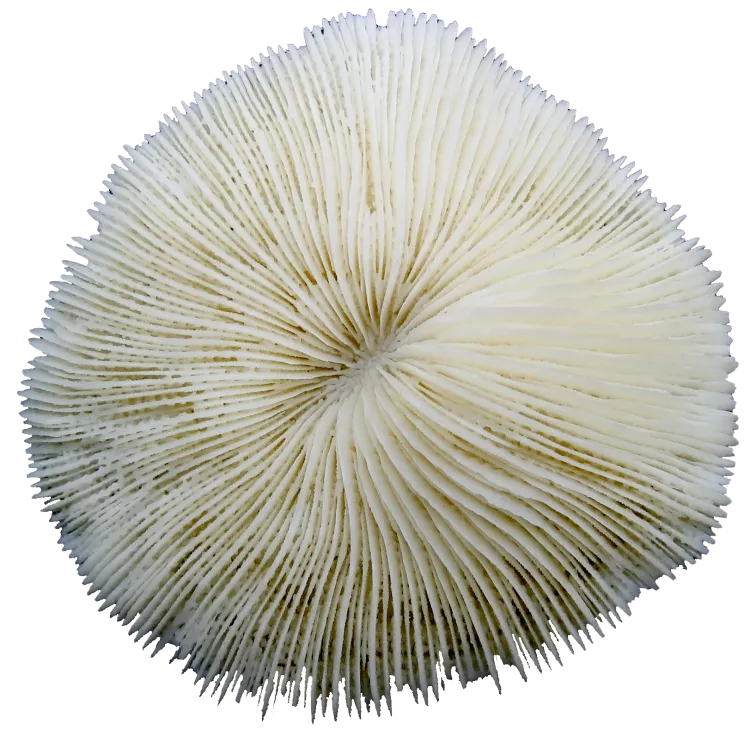
For example, as many of you will have seen, the strong acid hydrochloric acid, HCl, will dissolve chalk. This gives a solution of calcium chloride and carbonic acid, which then dissociates to produce water and the emission of a froth of bubbles of CO2.
This is shown in the following reaction. Note that it is not an equilibrium; it only goes one way as the CO2 is continually removed as a gas.
CaCO3 + 2H+ + 2Cl- →
Ca++ + 2Cl- + CO2 + H2O
With carbonic acid, however, which is a weak acid, a different reaction occurs. When there is excess CO2 dissolved in the water, the following equilibrium occurs in which the bicarbonate ion is formed:
Equilibrium A
CO2 + H2O + CaCO3 <=>
Ca++ + 2HCO3-
The right hand side of the equilibrium is thus a solution of calcium bicarbonate that, unlike calcium carbonate, is quite soluble, having a solubility of 166 g per litre. However, it exists only in solution. This solution contains calcium ions, carbon dioxide, bicarbonate ions and carbonate ions.
As this is an equilibrium, the more CO2 pushed into the left hand side of the equilibrium, the more it will force the equilibrium to the right i.e. the more the insoluble calcium carbonate will be changed into the soluble bicarbonate.
Incidentally, the bicarbonate ion is useful in the kitchen were it is to be found in NaHCO3, sodium bicarbonate, better known as baking soda. When it combines with moisture and an acidic ingredient such as milk (pH about 6.4), bubbles of CO2 are formed that expand under the oven temperature, causing the cake, or what ever is being made, to rise.
Unlike sodium bicarbonate, which exists as a dry solid, calcium bicarbonate does not. If an attempt is made to prepare calcium bicarbonate by evaporating its solution to dryness, solid calcium carbonate will be obtained instead, together with water and CO2 as shown in the following reaction.
Reaction B
aqueous Ca(HCO3)2 → gaseous CO2 + gaseous H2O + solid CaCO3
This reaction is important, for example, in the formation of speleothems such as stalactites and stalagmites.
Water picks up CO2 as it passes through the atmosphere and through the topsoil. As it flows past limestone, chalk and other minerals containing calcium carbonate, it dissolves some of this carbonate, forming bicarbonate by the process given in equilibrium A above. When this solution reaches the roof of a subterranean cave, the water will evaporate, and insoluble calcium carbonate will be formed as shown by reaction B. As this is formed preferentially where the evaporation is greatest i.e. at the lower ends of protuberances, increasingly longer formations will be formed.
Reaction B is thus important for understanding certain geological processes. However, it is reaction A that is the most important for understanding the effect of CO2 on life on Earth. It is fundamental, in fact, for understanding the effect of the increase of CO2 on the chemistry of seawater and on the life in it.
Acidity of the oceans
The acidity of the oceans can arise from two main sources.
- Acid rain, which is formed when rain water absorbes CO2, together with nitric acid and sulphuric acid, on its fall through the atmosphere.
- Direct absorption of CO2 in the surface water layer.
Although acid rain is obviously important for terrestrial life, it seems to play a minor role in making sea water more acidic on a global scale. Its impact, though, is somewhat greater in shallower waters such as the coastal regions. It is the direct absorbtion of CO2 by the surface of the sea water itself and the corresponding impact on its chemistry that affects marine creatures. We therefore concentrate here on the acidity arising from absorption of CO2.
Since about 1800 i.e. from the start of industrialisation in Europe, the amount of CO2 in the atmosphere has increased by about 36%, from 280 parts per million (ppm) to 380 ppm i.e. 0.038%. It is claimed that nearly 50% of the CO2 released due to human activities over the last 200 years has been absorbed by the oceans.
Currently, the oceans absorb about 22 tons of CO2 per day. However, the oceans tend to mix rather slowly and, because CO2 mainly enters the water by gas exchange at the surface, most CO2 is found in the top layers of the oceans or in the shallow seas. This means that the acidity is not completely uniform throughout the oceans.
Deep cold waters, which only circulate to the surface very slowly, are far from being saturated. In 2005, the warm waters around the widely separated islands of the Canaries, Hawaii and Bermuda, had a pH of ca 8.09.
It is important to remember, especially in these times of global warming, that warm water dissolves less CO2 than cold water. This means that, according to equilibrium A, this will favour the production of carbonate over bicarbonate.
As stated, the pH of seawater varies both in time and place, and due to the equilibrium A given above, even small local changes in pH towards the acidic can have great effects on marine life. For example, as the deep currents circulate around the globe, they eventually arrive in the North Pacific where they rise to the surface before plunging down deep again to continue on their deep journey.
As it upwells, the cold water absorbs more CO2 from the atmosphere, which means that equilibrium is pushed to the right giving an increased production of bicarbonate ions at the expense of carbonate ions.
Effect on marine fauna
Most of shell-forming molluscs which utilise CaCO3 to form their shells belong to two classes: the Gastropoda i.e. the univalves, snails, and the Bivalvia i.e. the clams, oysters, scallops, etc. Other classes of molluscs that form calcium carbonate shells are the Scaphopoda (the tusk shells), the Polyplacophora (the chitons) and the Monoplacophors (for example the deep sea Neopilina).
Some echinoderms such as starfish, sea urchins and sand dollars have hard exoskeletons formed of calcium carbonate, as do some annelid worms; and so, of course, do the reef structures of corals.
All shells of the mollusca are composed of basically the same material. This is calcium carbonate, in the form of calcite or aragonite, crystallised out in an organic matrix and laid down in layers by the shell glands of the mantle tissue. Aragonite and calcite are two polymorphs of CaCO3 in which the crystal structures differ.
Aragonite forms naturally in almost all mollusc shells as well as in the endoskeletons of both warm- and cold-water corals. In some mollusca, the entire shell is aragonite, while in others, it is a mixture of both aragonite and calcite. These shell-forming animals produce their calcium carbonate shells or skeletons from the CO3- - ions in the sea water.
The shells of crustacea, such as lobsters, crabs and shrimps are different in that they are built up from only 30-50% calcium carbonate together with 30-40% protein and 20-30% chitin. Chitin is a polysaccaride polymer also found in the exoskeletons of terrestrial insects.
Now, we have seen that the insolubility of calcium carbonate in seawater depends on its acidity i.e. its pH value; and as the concentration of CO2 in the water increases, the carbonate ion concentration decreases. There will therefore be less material for animals to build their shells.
This will inhibit calcification i.e. the process by which these animals rebuild their shells, and the skeletal growth rates of calcareous plankton, for example, will be reduced. Not only that, the increasing acidity can actually dissolve away the shells of oysters, clams, krill and pteropods, so that in areas of high CO2 concentration these animal will die.
Creatures with shells living at higher, colder, latitudes, and also in near-shore waters, will therefore probably be in the most trouble. For example, shell-building planktonic organisms such as the coccolithophorids and foraminifera are an important basis of the food chain in the waters of Antartica which, being cold, can absorb greater amounts of CO2. The increasing CO2 content of sea water will also affect the thickness and strength of lobster and other crustacea shells thus affecting their ability to survive in their normal habitats.
Although protected by their spines, echinoderms are preyed upon by, among others, the triton shell, the trigger fish, crabs and shrimps, and by other carnivorous echinoderms. Echinoderms also serve as hosts to many symbiotic shrimps, crabs, worms, snails and even some fish. Any change in the ability of these creatures to form their protective armour, and to survive in their present environment, could therefore be a disaster for both host and prey.
Krill and pteropods are major food source for juvenile salmon, herring, pollock, cod mackerel and many other fish. Disturbing the lower end of a food chain can have dramatic effects at the higher end of the chain. As these organisms provide food and habitat for other species fewer of these animals will then have a feedback effect on the populations of their predators and their prey. Entire eco-systems can therefore change or even completely disappear for ever.
Although unaffected by decalcification, squid are also sensitive to higher acidities, which affect their blood circulation and respiration.
The future
The situation is very complex. The increasing amount of CO2 in the atmosphere will lead to an increased uptake of CO2 in the oceans. However, the increasing level of CO2 is leading to an increase in global temperature thereby causing ocean water temperatures to rise. This increase in water temperature will then decrease the solubility of CO2. So, will we arrive back at the status quo or will there be a permanent change in the CO2 content of the oceans? At this time, it is not known how this interaction will be resolved.
Some things do already appear to be clear, though. The surface waters will become more and more saturated with CO2 so that in the short term, the oceans will probably become a much less efficient sink for CO2. This will obviously have an effect on the Earth’s climate.
In, say, less than 100 years, it is estimated that the pH of the oceans could drop by half a unit to about 7.7 i.e. a 5 times increase in acidity, with the amount of carbonate available to marine organisms dropping by 60%. And some scientists believe that in less than 50 years, the oceans could become too acidic for corals to survive at all.
Although the future may seem somewhat black for the marine fauna, the increase in CO2 content of the oceans may actually be beneficial to a number of marine flora, for example the sea grasses, although this is not certain.
In the long run, it is estimated that over a period of several thousand years about 90% of the anthropogenic CO2 emission will end up in the oceans, and that the pH of the oceans could be lowered permanently. It is somewhat naive perhaps, but we must assume that humans are sensible enough, and clever enough, to reduce CO2 emissions to a level below that which they are today.
What the effect on marine life will be of all the already accumulated CO2 in the oceans is, however, unclear. One thing seems to be certain though: it probably won’t be a benign effect.

